A couple of weeks ago, one of our specwriters called to ask me this question and I knew the answer immediately. Then…hmmm…I thought about it, and talked to myself for a while as he sat on the other end of the phone waiting for both of my selves to come to an agreement.
It was such a good question that I thought I’d post it here as a little challenge. If you need more information or if you think you know the answer (including a brief explanation beyond yes, no, or maybe), click here and scroll down to post a comment. I will hold all of the answers until 9/18, and one of the correct answerers will receive something from the Ingersoll Rand Prize Vault. If nothing else, you’ll all feel my pain when I have to look up the answer to one of your questions!
Question: On a new nursing home in New Hampshire (IBC 2006), the architect wants to add a small closet (door 110B.2 below). Does the glass in the window adjacent to the closet door need to be changed to impact-resistant glass?
Note: CPSC 16 CFR 1201 indicates impact-resistance, but if you really want to read the standard, here it is.
Hint:
1) Is the window considered a “hazardous location?”
2) If it is a hazardous location, are there any exceptions that would apply?
Here’s everything you need to know from IBC 2006:
SECTION 2406 – SAFETY GLAZING
2406.1 Human impact loads. Individual glazed areas, including glass mirrors, in hazardous locations as defined in Section 2406.3 shall comply with Sections 2406.1.1 through 2406.1.4.
2406.1.1 CPSC 16 CFR 1201. Except as provided in Sections 2406.1.2 through 2406.1.4, all glazing shall pass the test requirements of CPSC 16 CFR 1201, listed in Chapter 35. Glazing shall comply with the CPSC 16 CFR, Part 1201 criteria, for Category I or II as indicated in Table 2406.1.
2406.1.2 Plastic glazing. Plastic glazing shall meet the weathering requirements of ANSI Z97.1.
2406.1.3 Glass block. Glass-block walls shall comply with Section 2101.2.5.
2406.1.4 Louvered windows and jalousies. Louvered windows and jalousies shall comply with Section 2403.5.

2406.3 Hazardous locations. The following shall be considered specific hazardous locations requiring safety glazing materials:
1. Glazing in swinging doors except jalousies (see Section 2406.3.1).
2. Glazing in fixed and sliding panels of sliding door assemblies and panels in sliding and bifold closet door assemblies.
3. Glazing in storm doors.
4. Glazing in unframed swinging doors.
5. Glazing in doors and enclosures for hot tubs, whirlpools, saunas, steam rooms, bathtubs and showers. Glazing in any portion of a building wall enclosing these compartments where the bottom exposed edge of the glazing is less than 60 inches (1524 mm) above a standing surface.
6. Glazing in an individual fixed or operable panel adjacent to a door where the nearest exposed edge of the glazing is within a 24-inch (610 mm) arc of either vertical edge of the door in a closed position and where the bottom exposed edge of the glazing is less than 60 inches (1524 mm) above the walking surface.
- Exceptions:
- 1. Panels where there is an intervening wall or other permanent barrier between the door and glazing.
- 2. Where access through the door is to a closet or storage area 3 feet (914 mm) or less in depth. Glazing in this application shall comply with Section 2406.3, Item 7.
- 3. Glazing in walls perpendicular to the plane of the door in a closed position, other than the wall towards which the door swings when opened, in one- and two-family dwellings or within dwelling units in Group R-2.
7. Glazing in an individual fixed or operable panel, other than in those locations described in preceding Items 5 and 6, which meets all of the following conditions:
7.1. Exposed area of an individual pane greater than 9 square feet (0.84 m2);
7.2. Exposed bottom edge less than 18 inches (457 mm) above the floor;
7.3. Exposed top edge greater than 36 inches (914 mm) above the floor; and
7.4. One or more walking surface(s) within 36 inches (914 mm) horizontally of the plane of the glazing.
- Exception: Safety glazing for Item 7 is not required for the following installations:
- 1. A protective bar 11/2 inches (38 mm) or more in height, capable of withstanding a horizontal load of 50 pounds plf (730 N/m) without contacting the glass, is installed on the accessible sides of the glazing 34 inches to 38 inches (864 mm to 965 mm) above the floor.
- 2. The outboard pane in insulating glass units or multiple glazing where the bottom exposed edge of the glass is 25 feet (7620 mm) or more above any grade, roof, walking surface or other horizontal or sloped (within 45 degrees of horizontal) (0.78 rad) surface adjacent to the glass exterior.
8. Glazing in guards and railings, including structural baluster panels and nonstructural in-fill panels, regardless of area or height above a walking surface.
9. Glazing in walls and fences enclosing indoor and outdoor swimming pools, hot tubs and spas where all of the following conditions are present:
9.1. The bottom edge of the glazing on the pool or spa side is less than 60 inches (1524 mm) above a walking surface on the pool or spa side of the glazing; and
9.2. The glazing is within 60 inches (1524 mm) horizontally of the water’s edge of a swimming pool or spa.
10. Glazing adjacent to stairways, landings and ramps within 36 inches (914 mm) horizontally of a walking surface; when the exposed surface of the glass is less than 60 inches (1524 mm) above the plane of the adjacent walking surface.
11. Glazing adjacent to stairways within 60 inches (1524 mm) horizontally of the bottom tread of a stairway in any direction when the exposed surface of the glass is less than 60 inches (1524 mm) above the nose of the tread.
- Exception: Safety glazing for Item 10 or 11 is not required for the following installations where:
- 1. The side of a stairway, landing or ramp which has a guardrail or handrail, including balusters or in-fill panels, complying with the provisions of Sections 1013 and 1607.7; and
- 2. The plane of the glass is greater than 18 inches (457 mm) from the railing.
2406.3.1 Exceptions. The following products, materials and uses shall not be considered specific hazardous locations:
1. Openings in doors through which a 3-inch (76 mm) sphere is unable to pass.
2. Decorative glass in Section 2406.3, Item 1, 6 or 7.
3. Glazing materials used as curved glazed panels in revolving doors.
4. Commercial refrigerated cabinet glazed doors.
5. Glass-block panels complying with Section 2101.2.5.
6. Louvered windows and jalousies complying with the requirements of Section 2403.5.
7. Mirrors and other glass panels mounted or hung on a surface that provides a continuous backing support.
Floor plan and elevation courtesy of James Sykes of MorrisSwitzer~Environments for Health, LLC.
You need to login or register to bookmark/favorite this content.


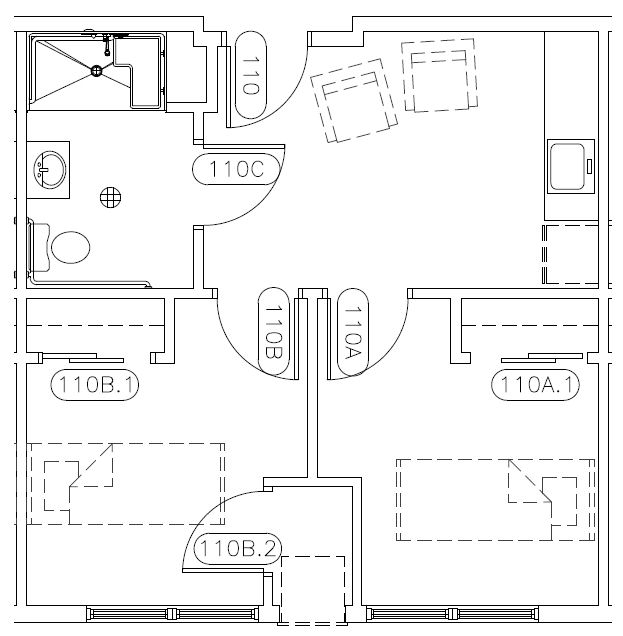

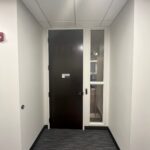
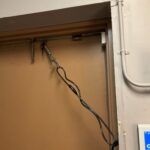
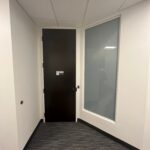
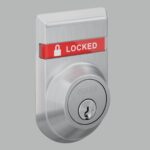
Hey Lori!
Great question to post. I love turning to this 6-page chapter every time I feel like beating my head against the wall! So now with a headache, I’ll take a shot at an answer. No it does not require impact resistant glass as it does not meet the hazardous location requirement based on 2406.3, Item 6, exception 3. Exception 2 would not apply as this window location does not meet all of the conditions in Item 7, plus there are some interpretation issues with that exception.
Thanks for the fun! Maybe I’ll see you in Orlando!
Mark
Mark,I’m confused. What about the part that says, “other than the wall towards which the door swings when opened”…
Maybe I’m so late. It not necessary to change the glass to impact-resistant.
Hey Lorie
Can we apply decorative mirror on closet steel doors UL 90 min inside hotel suite to hide these doors (it is double door closet)
Hi Nabil –
I don’t think any manufacturer’s listings would allow mirrors on 90-minute fire doors, but I’m wondering why closet doors in a hotel suite are 90-minute fire doors. That’s unusual.
– Lori